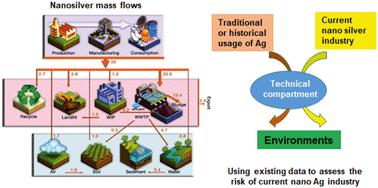Engineered silver nanoparticles in terrestrial environments: a meta-analysis shows that the overall environmental risk is small†
Abstract
Engineered silver nanoparticles (Ag-ENPs) are widely used in a range of biocidal and consumable products, raising concerns regarding their potential risks upon release into the environment. Both Ag and Ag-ENPs have a long history of usage (e.g. at least 12 decades for Ag-ENPs). This historical usage of Ag, together with its concomitant release into the environment, provides a source of information for assessing whether newly emerging Ag-based nanotechnology constitutes an environmental risk. Here, we have utilized a meta-analysis to examine the behavior of Ag along the ‘source – waste water treatment plant (WWTP) – soil – receptor’ pathway. This is because, when total Ag is considered (i.e. bulk Ag plus Ag-ENPs), the majority of what is released into the environment accumulates in agricultural soils due to the application of sludge from WWTPs. However, the mass flow of Ag-ENPs entering soils only represents a small fraction of the total Ag, with the concentrations of Ag-ENPs in soil generally three orders of magnitude lower than the total Ag concentrations for field-measured values in sludge-treated soils. Furthermore, most Ag-ENPs lose their engineered nano-properties and are sulfidated to Ag2S within WWTPs before being applied to agricultural soils. Importantly, the Ag2S produced is very stable in soils, with the soluble Ag concentration being very low (generally ≤6 μg L−1) – this being at least six orders of magnitude lower than the no-observed-effect concentrations reported for plant growth and terrestrial fauna in soils. Accordingly, the bioaccumulation of Ag in edible plant tissues in sludge-treated soils is also much lower than the maximum permissible levels of Ag in diets for animals. Taken together, the risk of Ag-ENPs to terrestrial plants and fauna (including humans through trophic transfer) is small. However, the usage of Ag-ENP products may potentially pose a risk to soil microbial communities and in natural waters, and more research is needed in these areas.



 Please wait while we load your content...
Please wait while we load your content...